Visualization of RNA Using Fluorescence Complementation Triggered by Aptamer‐Protein Interactions (RFAP) in Live Bacterial Cells
互联网
- Abstract
- Table of Contents
- Materials
- Figures
- Literature Cited
Abstract
This unit describes a method allowing RNA visualization in live cells. The method is based on fluorescent protein complementation regulated by RNA?aptamer/RNA?binding protein interactions. Based on these two principles, a fluorescent ribonucleoprotein complex is assembled inside the cell only in response to the presence of the aptamer sequence on the target RNA. Curr. Protoc. Cell Biol. 37:17.11.1?17.11.20. © 2007 by John Wiley & Sons, Inc.
Keywords: protein complementation; aptamer?protein interactions; RNA localization; fluorescent proteins; eukaryotic initiation factor 4A; bacterial cells
Table of Contents
- Introduction
- Basic Protocol 1: Design and Cloning of DNA Contructs for the Expression of Protein and RNA Components of the Complementation Complex
- Basic Protocol 2: Expression of RNA Labeling Components in E. Coli
- Basic Protocol 3: Analysis of Cells by Flow Cytometry
- Basic Protocol 4: Analysis of Cells by Microscopy
- Commentary
- Literature Cited
- Figures
- Tables
Materials
Basic Protocol 1: Design and Cloning of DNA Contructs for the Expression of Protein and RNA Components of the Complementation Complex
Materials
Basic Protocol 2: Expression of RNA Labeling Components in E. Coli
Materials
Basic Protocol 3: Analysis of Cells by Flow Cytometry
Materials
Basic Protocol 4: Analysis of Cells by Microscopy
Materials
|
Figures
-

Figure 17.11.1 Diagram of RFAP assay for localization and detection of RNA in vivo. Two fragments (A and B) of the enhanced green fluorescent protein (EGFP) are fused to two fragments (F1 and F2) of eukaryotic initiation factor 4A (eIF4A), an RNA‐binding protein. These protein fusions are coexpressed in the presence of an RNA target modified with eIF4A‐interactive aptamer sequence inserted into the 3′ UTR of the gene. Binding of F1 and F2 fragments of eIF4A to the aptamer motif brings the EGFP fragments in close proximity to reconstitute a functional fluorescent protein. This RNP complex generates a signal that can be used to track RNA in real time. View Image -

Figure 17.11.2 Schematics of the design of RNA‐interacting protein fusions. Carboxy‐terminal fusions of EGFP fragments to eIF4A fragments were made with an intervening linker sequence of 10 amino acid residues. View Image -

Figure 17.11.3 Step‐wise cloning of EGFP and eIF4A fragments into prokaryotic expression vectors. Each fragment is PCR‐amplified and cloned into two different vectors used for the coexpression of one or more genes in bacteria. The A and F1 fragments are cloned between Nco I‐ BamH I and Sa lI‐ Not I sites of pACYCDuet‐1, respectively. Fragments B and F2 are cloned in a similar manner, but in vector pETDuet‐1. These constructs are later used in the fusion of these fragments as in (also see Figure ). View Image -

Figure 17.11.4 Outline of the procedure followed to create A‐F1 and B‐F2 fusions without the need for subcloning (Vasl et al., ). This procedure consists of four basic steps: (1) linearization of template plasmids using different restriction enzymes; (2) PCR using linearized templates and phosphorylated primers; (3) isolation of product and removal of template plasmids; (4) ligation and transformation of product into competent E. coli cells. View Image -

Figure 17.11.5 Localization of untranslated RNA in live bacterial cells using the RFAP method. The left‐hand side of the figure illustrates expression of two protein fusions, each containing a fragment of a split eIF4A and a split EGFP, that does not result in a fluorescent signal. The right‐hand side of the figure illustrates coexpression of two protein fusions and the RNA transcript with aptamer, which results in a fluorescent signal often localized to the cell. Top row, molecular constructs expressed in E.coli ; second row, plasmids expressing components of the complementation complex; third row, fluorescence distributions of cells expressing EGFP‐complementing complexes, obtained by flow cytometry—black, before IPTG induction, red, after IPTG induction; and bottom row, fluorescence micrographs of E. coli cells expressing corresponding components of the complementing complexes. Scale bar = 2 µm. View Image
Videos
Literature Cited
| Literature Cited | |
| Anderson, P., and Kedersha, N. 2006. RNA granules. J. Cell Biol. 172:803‐808. | |
| Beach, D.L., and Bloom, K. 2001. ASH1 mRNA localization in three acts. Mol. Biol. Cell. 12:2567‐2577. | |
| Beach, D.L., Salmon, E.D., and Bloom, K. 1999. Localization and anchoring of mRNA in budding yeast. Curr. Biol. 9:569‐578. | |
| Bertrand, E., Chartrand, P., Schaefer, M., Shenoy, S.M., Singer, R.H., and Long. R.M. 1998. Localization of ASH1 mRNA particles in living yeast. Mol. Cell. 2:437‐445. | |
| Bratu, D.P., Cha, B.J., Mhlanga, M.M., Kramer, F.R., and Tyagi S. 2003. Visualizing the distribution and transport of mRNAs in living cells. Proc. Natl. Acad. Sci. U.S.A. 100:13308‐13313. | |
| Caruthers, J.M., Johnson, E.R., and McKay, D.B. 2000. Crystal structure of yeast initiation factor 4A, a DEAD‐box RNA helicase. Proc. Natl. Acad. Sci. U.S.A. 97:13080‐13085. | |
| Corral‐Debrinski, M., Blugeon, C., and Jacq, C. 2000. In yeast, the 3′ untranslated region or the presequence of ATM1 is required for the exclusive localization of its mRNA to the vicinity of mitochondria. Mol. Cell Biol. 20:7881‐7892. | |
| Czaplinski, K. and Singer, R.H. 2006. Pathways for mRNA localization in the cytoplasm. Trends Biochem. Sci. 31:687‐693. | |
| Choi, K.H., Park, M.W., Lee, S.Y., Jeon, M.Y., Kim, M.Y., Lee, H.K., Yu, J., Kim, H.J., Han, K., Lee, H., Park, K., Park, W.J., and Jeong, S. 2006. Intracellular expression of the T‐cell factor‐1 RNA aptamer as an intramer. Mol. Cancer Ther. 5:2428‐2434. | |
| Chubb, J.R., Trcek, T., Shenoy, S.M., and Singer, R.H. 2006. Transcriptional pulsing of a developmental gene. Curr. Biol. 16:1018‐1025. | |
| Demidov, V.V., Dokholyan, N.V., Witte‐Hoffmann, C., Chalasani, P., Yiu, H.W., Ding, F., Yu, Y., Cantor, C.R., and Broude, N.E. 2006. Fast complementation of split fluorescent protein triggered by DNA hybridization. Proc. Natl. Acad. Sci. U.S.A. 103:2052‐2056. | |
| de Virgilio, M., Kiosses, W.B., and Shattil, S.J. 2004. Proximal, selective, and dynamic interactions between integrin alphaIIbbeta3 and protein tyrosine kinases in living cells. J. Cell Biol. 165:305‐311. | |
| Dirks, R.W. and Tanke, H.J. 2006. Advances in fluorescent tracking of nucleic acids in living cells. Biotechniques 40:489‐496. | |
| Ellington, A.D. and Szostak, J.W. 1990. In vitro selection of RNA molecules that bind specific ligands. Nature 346:818‐822. | |
| Fusco, D., Accornero, N., Lavoie, B., Shenoy, S.M., Blanchard, J.M., Singer, R.H., and Bertrand E. 2003. Single mRNA molecules demonstrate probabilistic movement in living mammalian cells. Curr. Biol. 13:161‐167. | |
| Johnsson, N. and Varshavsky, A. 1994. Ubiquitin‐assisted dissection of protein transport across membranes. EMBO J. 13:2686‐2698. | |
| Geiser, M., Cebe, R., Drewello, D. and Schmitz, R. 2001. Integration of PCR fragments at any specific site within cloning vectors without the use of restriction enzymes and DNA ligase. Biotechniques 31:88‐92. | |
| Golding, I. and Cox, E.C. 2004. RNA dynamics in live Escherichia coli cells. Proc. Natl. Acad. Sci. U.S.A. 101:11310‐11315. | |
| Golding, I., Paulsson, J., Zawilski, S.M., and Cox, E.C. 2005. Real‐time kinetics of gene activity in individual bacteria. Cell 123:1025‐1036. | |
| Ghosh, I., Hamilton, A.D., and Regan, L. 2000. Antiparallel leucine zipper‐directed protein reassembly: Application to green fluorescent protein. J. Am. Chem. Soc. 122:5658‐5659. | |
| Hafner, M., Schmitz, A., Grune, I., Srivatsan, S.G., Paul, B., Kolanus, W., Quast, T., Kremmer, E., Bauer, I., and Famulok, M. 2006. Inhibition of cytohesins by SecinH3 leads to hepatic insulin resistance. Nature 444:941‐944. | |
| Hanson, S., Berthelot, K., Fink, B., McCarthy, J.E., and Suess, B. 2003. Tetracycline‐aptamer‐mediated translational regulation in yeast. Mol. Microbiol. 49:1627‐1637. | |
| Hermann, T. and Patel, D.J. 2000. Adaptive recognition by nucleic acid aptamers. Science 287:820‐825. | |
| Hu, C.D. and Kerppola, T.K. 2003. Simultaneous visualization of multiple protein interactions in living cells using multicolor fluorescence complementation analysis. Nat. Biotechnol. 21:539‐545. | |
| Hu, C.D., Chinenov, Y., and Kerppola, T.K. 2002. Visualization of interactions among bZIP and Rel family proteins in living cells using bimolecular fluorescence complementation. Mol. Cell. 9:789‐798. | |
| Huttenhofer, A., Schattner, P., and Polacek, N. 2005. Non‐coding RNAs: Hope or hype? Trends Genet. 21:289‐297. | |
| Kiss, T. 2002. Small nucleolar RNAs: An abundant group of noncoding RNAs with diverse cellular functions. Cell 109:145‐148. | |
| Kloc, M., Zearfoss, N.R., and Etkin, L.D. 2002. Mechanisms of subcellular mRNA localization. Cell 108:533‐544. | |
| Le, T.T., Harlepp, S., Guet, C.C., Dittmar, K., Emonet, T., Pan, T., and Cluzel, P. 2005. Real‐time RNA profiling within a single bacterium. Proc. Natl. Acad. Sci. U.S.A. 102:9160‐9164. | |
| MacDonald, M.L. and Westwick, J.K. 2007. Exploiting network biology to improve drug discovery. Methods Mol. Biol. 356:221‐232. | |
| MacDonald, M.L., Lamerdin, J., Owens, S., Keon, B.H., Bilter, G.K., Shang, Z., Huang, Z., Yu, H., Dias, J., Minami, T., Michnick, S.W., and Westwick, J.K. 2006. Identifying off‐target effects and hidden phenotypes of drugs in human cells. Nat. Chem. Biol. 2:329‐337. | |
| Magliery, T.J., Wilson, C.G., Pan, W., Mishler, D., Ghosh, I., Hamilton, A.D., and Regan, L. 2005. Detecting protein‐protein interactions with a green fluorescent protein fragment reassembly trap: Scope and mechanism. J. Am. Chem. Soc.127:146‐157. | |
| Mattick, J.S. 2003. Challenging the dogma: The hidden layer of non‐protein‐coding RNAs in complex organisms. Bioessays 25:930‐939. | |
| Mi, J., Zhang, X., Rabbani, Z.N., Liu, Y., Su, Z., Vujaskovic, Z., Kontos, C.D., Sullenger, B.A., and Clary, B.M. 2006. H1 RNA polymerase III promoter‐driven expression of an RNA aptamer leads to high‐level inhibition of intracellular protein activity. Nucleic Acids Res. 34:3577‐3584. | |
| Michnick, S.W. 2003. Protein fragment complementation strategies for biochemical network mapping. Curr. Opin. Biotechnol. 14:610‐617. | |
| Moore, D., Dowhan, D., Chory, J., and Ribaudo, R.K. 2002. Isolation and purification of large DNA restriction fragments from agarose gels. Curr. Protoc. Mol. Biol. 59:2.6.1‐2.6.12. | |
| Nickens, D.G., Patterson, J.T., and Burke, D.H. 2003. Inhibition of HIV‐1 reverse transcriptase by RNA aptamers in Escherichia coli. RNA. 9:1029‐1033. | |
| Nyfeler, B., Michnick, S.W., and Hauri, H.P. 2005. Capturing protein interactions in the secretory pathway of living cells. Proc. Natl. Acad. Sci. U.S.A. 102:6350‐6355. | |
| Oguro, A., Ohtsu, T., Svitkin, Y.V., Sonenberg, N,, and Nakamura, Y. 2003. RNA aptamers to initiation factor 4A helicase hinder cap‐dependent translation by blocking ATP hydrolysis. RNA 9:394‐407. | |
| Ooi, A.T., Stains, C.I., Ghosh, I., and Segal, D.J. 2006. Sequence‐enabled reassembly of beta‐lactamase (SEER‐LAC): A sensitive method for the detection of double‐stranded DNA. Biochemisry 45:3620‐3625. | |
| Ozawa, T., Nogami, S., Sato, M., Ohya, Y., and Umezawa, Y. 2000. A fluorescent indicator for detecting protein‐protein interactions in vivo based on protein splicing. Anal. Chem. 72:5151‐5157. | |
| Ozawa, T., Takeuchi, T.M., Kaihara, A., Sato, M., and Umezawa, Y. 2001a. Protein splicing‐based reconstitution of split green fluorescent protein for monitoring protein‐protein interactions in bacteria: Improved sensitivity and reduced screening time. Anal. Chem. 73:5866‐5874. | |
| Ozawa, T., Kaihara, A., Sato, M., Tachihara, K., and Umezawa, Y. 2001b. Split luciferase as an optical probe for detecting protein‐protein interactions in mammalian cells based on protein splicing. Anal. Chem. 73:2516‐2521. | |
| Paulmurugan, R., Umezawa, Y., and Gambhir, S.S. 2002. Noninvasive imaging of protein‐protein interactions in living subjects by using reporter protein complementation and reconstitution strategies. Proc. Natl. Acad. Sci. U.S.A. 99:15608‐15613. | |
| Pelletier, J.N., Campbell‐Valois, F.X., and Michnick, S.W. 1998. Oligomerization domain‐directed reassembly of active dihydrofolate reductase from rationally designed fragments. Proc. Natl. Acad. Sci. U.S.A. 95:12141‐12146. | |
| Rackham, O., and Brown, C.M. 2004. Visualization of RNA‐protein interactions in living cells: FMRP and IMP1 interact on mRNAs. EMBO J. 23:3346‐3355. | |
| Remy, I. and Michnick, S.W. 1999. Clonal selection and in vivo quantitation of protein interactions with protein‐fragment complementation assays. Proc. Natl. Acad. Sci. U.S.A. 96:5394‐5399. | |
| Remy, I. and Michnick, S.W. 2001. Visualization of biochemical networks in living cells. Proc. Natl. Acad. Sci. U.S.A. 98:7678‐7683. | |
| Remy, I. and Michnick, S.W. 2004. A cDNA library functional screening strategy based on fluorescent protein complementation assays to identify novel components of signaling pathways. Methods 32:381‐388. | |
| Remy, I. and Michnick, S.W. 2006. A highly sensitive protein‐protein interaction assay based on Gaussia luciferase. Nat. Methods 3:977‐979. | |
| Remy, I. and Michnick, S.W. 2007. Application of protein‐fragment complementation assays in cell biology. Biotechniques 42:137‐145. | |
| Remy, I., Montmarquette, A., and Michnick, S.W. 2004. PKB/Akt modulates TGF‐beta signalling through a direct interaction with Smad3. Nat. Cell Biol. 6:358‐365. | |
| Santangelo, P.J., Nix, B., Tsourkas, A. and Bao, G. 2004. Dual FRET molecular beacons for mRNA detection in living cells. Nucleic Acids Res. 32‐e57. | |
| Schmidt, U., Richter, K., Berger, A.B., Lichter, P. 2006. In vivo BiFC analysis of Y14 and NXF1 mRNA export complexes: Preferential localization within and around SC35 domains. J. Cell Biol. 172:373‐381. | |
| Seidman, C.E., Struhl, K., Sheen, J., and Jessen, T. 1997. Introduction of plasmid DNA into cells. Curr. Protoc. Mol. Biol. 37:1.8.1‐1.8.10. | |
| Silverman, A.P. and Kool, E.T. 2005. Quenched autoligation probes allow discrimination of live bacterial species by single nucleotide differences in rRNA. Nucleic Acids Res. 33:4978‐4986. | |
| Stains, C.I., Furman, J.L, Segal, D.J., and Ghosh, I. 2006. Site‐specific detection of DNA methylation utilizing mCpG‐SEER. J. Am. Chem. Soc. 128:9761‐9765. | |
| Takizawa, P.A. and Vale, R.D. 2000. The myosin motor, Myo4p, binds Ash1 mRNA via the adapter protein, She3p. Proc. Natl. Acad. Sci. U.S.A. 97:5273‐5278. | |
| Tuerk, C. and Gold, L. 1990. Systematic evolution of ligands by exponential enrichment: RNA ligands to bacteriophage T4 DNA polymerase. Science 249:505‐510. | |
| Valencia‐Burton, M., McCullough, R., Cantor, C.R., and Broude, N.E. 2007. RNA visualization in live bacterial cells using fluorescent protein complementation. Nature Meth. DOI 4 :421‐427. | |
| Vasl, J., Panter, G., Bencina, M., and Jerala, R. 2004. Preparation of chimeric genes without subcloning. Biotechniques 37:726‐730. | |
| Voytas, D. Agarose gel electrophoresis. Curr. Protoc. Mol. Biol. 51:2.5A.1‐2.5A.9. | |
| Wilson, K. 1997. Preparation of genomic DNA from bacteria. Curr. Protoc. Mol. Biol. 27:2.4.1‐2.4.5. | |
| Zhang, J., Campbell, R.E., Ting, A.Y., and Tsien, R.Y. 2002. Creating new fluorescent probes for cell biology. Nat. Rev. Mol. Cell Biol. 3:906‐918. |









